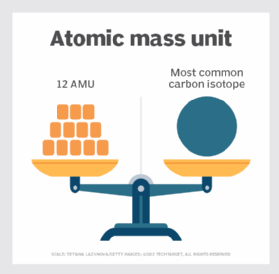The Atomic Mass Unit (amu)

The atomic mass unit (amu) is a unit of measurement used to express the mass of atomic and subatomic particles, such as protons, neutrons, and electrons, as well as the relative masses of atoms and molecules. It is defined as one twelfth of the mass of a carbon-12 atom.
Here are some key points about the atomic mass unit (amu):
Definition: The atomic mass unit is defined based on the mass of a carbon-12 (^12C) atom, which is assigned a mass of exactly 12 atomic mass units. This definition was established by the International Union of Pure and Applied Chemistry (IUPAC) and the International Union of Pure and Applied Physics (IUPAP).
Relative Mass: The atomic mass unit is a relative mass scale, meaning it provides a convenient way to compare the masses of different particles and atoms relative to each other. For example, the mass of a proton is approximately 1.0073 amu, while the mass of a neutron is approximately 1.0087 amu.
Approximation: Although the atomic mass unit is defined based on the mass of a carbon-12 atom, the actual mass of a carbon-12 atom is not precisely 12 amu. Instead, it is slightly less than 12 amu due to the presence of nuclear binding energy, which reduces the total mass of the nucleus compared to the sum of the masses of its individual protons and neutrons.
Used in Chemistry and Physics: The atomic mass unit is commonly used in chemistry and physics to express the masses of atoms, molecules, and subatomic particles. It provides a convenient scale for describing the relative masses of these particles without dealing with extremely small or large numbers.
Relationship to Avogadro's Number: Avogadro's number, which is approximately 6.022 × 10^23 particles per mole, relates the atomic mass unit to the macroscopic scale of grams. One mole of carbon-12 atoms has a mass of approximately 12 grams, which corresponds to Avogadro's number of carbon-12 atoms, each with a mass of approximately 12 amu.
In summary, the atomic mass unit is a fundamental unit of measurement used to express the masses of atomic and subatomic particles relative to the mass of a carbon-12 atom. It plays a crucial role in chemistry and physics for describing the masses of atoms, molecules, and particles at the atomic and molecular scale.
Thank you,